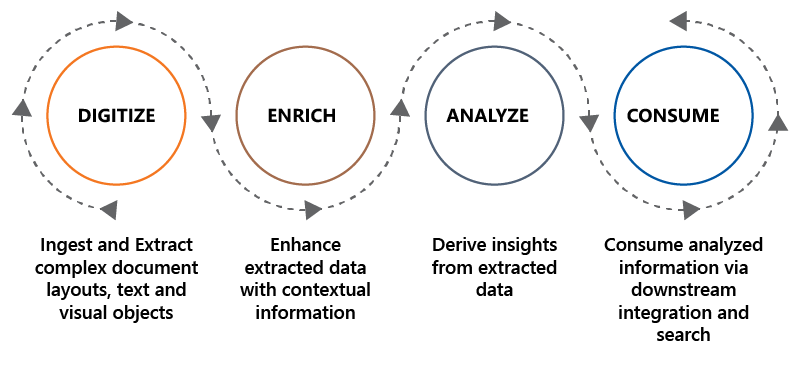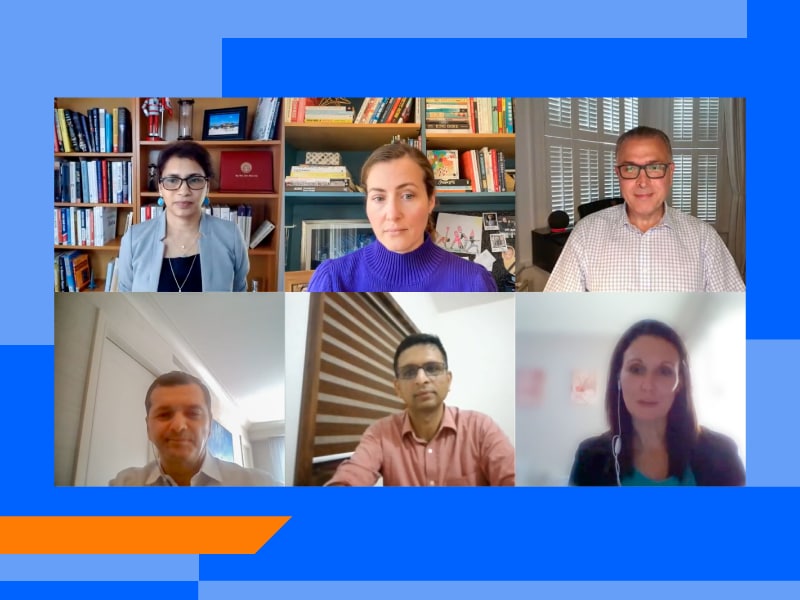All about Document AI
Data at the heart of digital transformation goals
80-90% of enterprise data is unstructured and locked in documents.
Document AI uses the power of Natural Language Processing and Machine Learning to train computers to aptly simulate humans when reviewing documents, reducing human errors and time taken.
Document AI is the need of the hour. The reason being data locked in documents creates bottlenecks for information processing and roadblocks to digital transformation. Today data comes in different formats, such as images, tables, signatures, bar codes, handwritten text, visuals, and logos. Most enterprises have business processes that deal with a massive volume of data that is locked away in scanned documents such as invoices, scanned paper forms, bank statements, financial statements, claims, receipts, legal contracts, and identification documents (like passport or driver’s license), etc. Sifting through these millions of physical documents to make sense of the data and derive meaningful insights is challenging. Manual data extraction from these documents is time-consuming, tedious, and prone to errors, impacting workforce productivity and business efficiency.
How then can organizations unlock insights or value from documents? How can enterprises mine unstructured data for valuable insights? Tapping into data in real-time to access insights required for decision-making can help enterprises save millions of dollars. Hence, only comprehensive Document AI extraction can address the current requirements for businesses.
Data is growing at a rapid pace today. IDC forecasts that by 2023, the Global DataSphere will grow to 102.6ZB. As enterprises gear up for a data-driven market, converting data into actionable insights opens up endless possibilities that were unimaginable in the past. Let’s look at the types of data that enterprises deal with today.
Different types of data structures
Structured vs. unstructured data
| Structured Data | Unstructured Data |
| Structured documents have organized with a clearly defined template | Unstructured documents do not have a predefined data model and do not map to any predefined layouts or templates. |
| Easy to sort, search, and analyze | Difficult to deconstruct and requires processing to make it understandable |
| Typically located in enterprise applications like ERP systems | Typically found in the form of contracts or emails |
| Examples: Insurance policy application forms, Bank KYC forms, etc | Examples: Contracts, emails, Invoices, financial statements, legal agreements, news articles |
| Capabilities required for processing: While OCR detects and extracts structured documents with ease and makes them machine-readable, AI/ML comes in handy for preprocessing low-quality scan images to improve extraction accuracy | Capabilities required for processing: Advanced AI/ML techniques like NLP help extract and comprehend data (intents and entities) from unstructured documents, and NLG helps create document summaries |
What is Document AI, and how does it help enterprises manage their data better?
Did you know that 70% of enterprise documents are free-form text, such as written documents and emails?
As per a report from analyst firm, Omdia, annual AI software revenue will grow six-fold in the next six years, hitting nearly $100 billion by 2025.
Businesses today are turning to Document AI solutions to successfully unlock business value from complex enterprise documents, while dealing with the increasing volume of ever-evolving document types.
Document AI uses advanced AI technologies such as computer vision, NLP, as well as deep learning models to extract intelligence hidden in unstructured data sources such as emails, PDFs, scanned documents, and images, among others. Structuring, sorting, and analyzing massive volumes of data can be daunting. Smart Document Analysis can make sense of the vast unstructured data, from invoices and purchase orders to contracts, thus streamlining and improving business processes.
AI is a game-changer when it comes to gleaning insights critical for faster and easier decision-making. Document AI solutions help unlock business value from enterprise data by extracting intelligence from all types of complex documents, from images to PDFs.
According to IDC Technology Spotlight Report, Document AI is defined as an “AI-based software that uses technologies such as computer vision, natural language processing, ontologies, and language analysis as well as deep learning models for harvesting intelligence from various data sources including email, PDFs, Word files, scanned documents, and/or images of documents.”
The IDC Technology Spotlight report, sponsored by EdgeVerve, outlines how AI solutions can help enterprises address document processing challenges, enabling strategic decision making.
What are the challenges Document AI helps address?
Enterprises have to deal with
80% of unstructured data
Manual document process results
in inaccuracy, errors, and reduced productivity
Untapped hidden insights impact
decision making
Common barriers to the successful implementation of Document AI
As described in IDC’s May 2019 Global Artificial Intelligence Survey, over half, or 51%, of AI initiatives have failed.
“Common barriers to the successful implementation of AI include costs, business readiness, AI applicability, data quality and access, defining success criteria, algorithms, and data science skills shortages.”
Though AI adoption is on the rise, enterprises face many barriers when implementing Document AI. Some of them are:
Benefits of Document AI
Ingest a wide array of diverse, domain specific and complex documents
Extract insights from visually rich documents
Unlock data stored in scanned and unstructured documents
Eliminate time-intensive, manual extraction of data from documents
Drives workforce productivity
Faster business decision making
Applications of Document AI
Use cases of AI in document management
Manually sifting through contracts, invoices, vendor agreements, and other documents is time-consuming, tedious, and stifles productivity. By integrating AI for documents, enterprises can overcome the challenges related to document management, improving productivity, and streamlining processes in the long run.
Below are a few Document AI use cases:
AI legal document analysis: Law firms also have to deal with countless documents, from reviewing contracts and ensuring fast-track settlement negotiations to complying with regulations. Advanced digital technologies such as Artificial Intelligence, Machine Learning, Natural Language Processing, and Robotic Process Automation automate manual tasks, streamlining legal processes and offering actionable insights for informed decision making.
AI in insurance: AI is changing the insurance landscape, helping underwriters at the insurers overcome the challenges in new business document processing. For instance, when applied to the Underwriting process, Document AI helps automate back-end administrative tasks, ensuring efficiency and providing intelligence around risk profiles and claims.
How AI is changing the insurance landscape
This eBook, created in collaboration with EdgeVerve and AI Business, focuses on the potential of AI in the insurance space. It deep dives into the adoption of AI in commercial insurance, and how enterprises can overcome the challenges related to document processing.
Download the eBook to learn how AI is disrupting the commercial insurance space.
AI in banking: The banking industry is riddled with the need to process large volumes of documents in a short time span. For instance, AI Document Processing and Extraction solutions help various applications, from extracting underlying complex financial and legal risks in documents to automating loan processing or customer KYC processing.
Featured success story
One of our clients, a large US-based financial institution, was struggling to review and approve 25K+ loan applications in a week amid the pandemic.
With XtractEdge Platform, the client was able to accelerate loan processing and achieve a data accuracy of around 90%. Read more
Introducing XtractEdge, the comprehensive suite of Document AI platform & products by EdgeVerve
Unlock enterprise document intelligence
XtractEdge is a comprehensive suite of Document AI platform & products that enables enterprises to extract actionable insights from a wide variety of enterprise documents, contracts, and legal agreements. At EdgeVerve, we have deployed two key Document AI solutions — XtractEdge Platform and XtractEdge Contract Analysis to help our clients successfully unlock business value from enterprise documents regardless of their complexity or domain specificity.
XtractEdge Platform
Optimizes the document extraction, processing, and comprehension pipeline to help enterprises unlock business value faster. With its advanced AI capabilities that use an ensemble of various Machine Learning and Deep Learning based techniques, flexible data management and analytics pipelines, XtractEdge Platform structures the world’s complex multi-document data, making it consumption ready to unlock the latent business value.
XtractEdge Contract Analysis
leverages advanced Machine Learning techniques to help customers across industries derive insights from contracts and other legal documents, thus enhancing contract review and analysis.
How does Document AI work
A Document AI solution works in four stages. It digitizes documents across various forms and formats, enriches the extracted data with contextual information, derives insights from the extracted data, and makes it available for consumption.
Learn more about XtractEdge, recognized as one of the top Document AI platforms for large enterprises.
Resources
Learn more about Document AI

Thanks for your interest!
Our team will get in touch with you soon.







